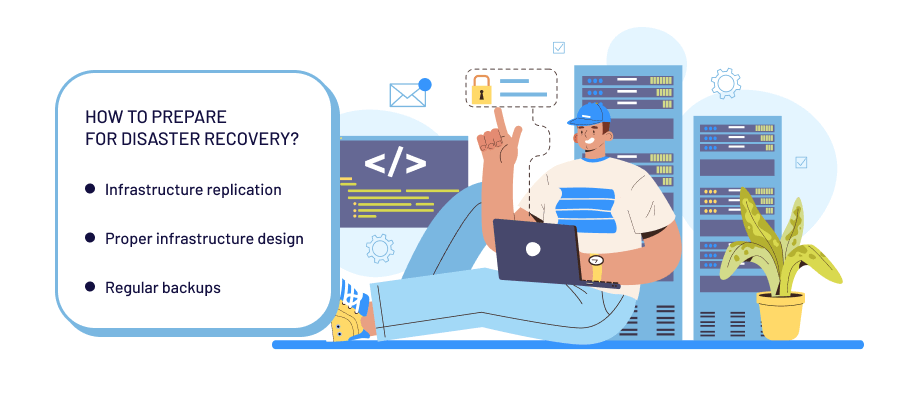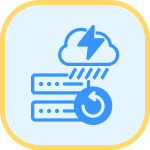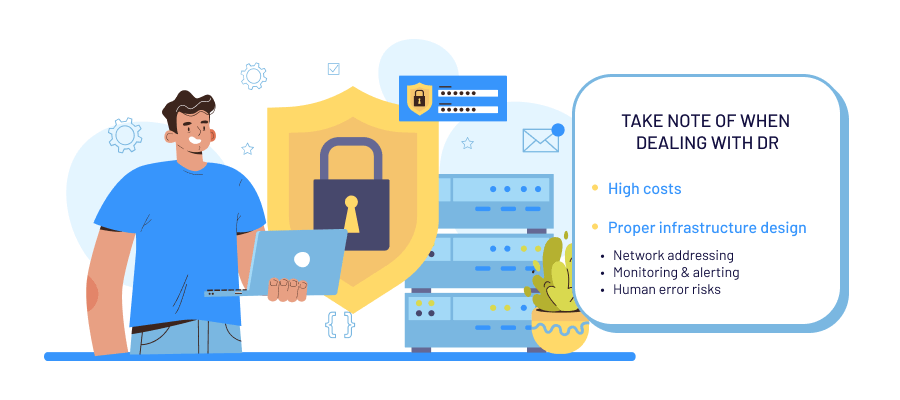Nothing is 100% insured from force majeures and glitches. Even if you have a well-designed IT system, external factors may affect its sustainability.
However, not all business owners keep this simple thing in mind and don’t even give a thought to how they are going to restore their infrastructure and access to mission-critical data if something happens. Indeed, natural hazards occur rarely, and the architecture is well thought-out to prevent data breaches. So, why would I care and bother with disaster recovery settings, especially if my application is deployed in the cloud, you may ask?
If it’s your way of thinking, remember Murphy’s law. And the consequences may turn out the way that if something occurs, you will lose much more than in dealing with disaster recovery configurations.
This is exactly what we’d like to touch upon in this article. Why is disaster recovery an important thing among other cloud services? Why is it essential for system resilience, what are the main must-dos when designing your infrastructure, and which hurdles can we expect? Let’s figure it out.
Why Cloud Disaster Recovery Is Essential for Business Resilience

First, it’s important to figure out what is a disaster in the context of an application. The first things that come to mind are natural cataclysms, such as fire or tsunami, put simply, something that can physically destroy your hardware. But I have my infrastructure and data in the cloud, and such disasters don’t scare me at all, you might object.
The belief that the cloud is something totally and completely virtual is erroneous. All cloud providers have their physical data centers with necessary hardware and periphery, susceptible to fire, floods, or earthquakes. Therefore, if we consider this aspect, there’s no difference with your own DC.
However, all cloud servers have an Internet connection which can also be interrupted suddenly. Yes, this seemingly minor thing as an interrupted Internet connection is also considered a disaster if we speak about cloud applications.
There was one striking example related to GitHub. Several years ago, there were maintenance works that resulted in the loss of connectivity between the US East Coast Network Hub and their primary US West Coast data center. It was restored in less than a minute, however, this seemingly minor accident resulted in 24h+ service degradation.
Therefore, those using these data centers were cut off from the connection and couldn’t leave any comments. This is critical if you have a system implying continuous DevOps activities with ongoing CI/CD pipelines and service requiring regular updating, say 2-3 per day. Imagine, what losses these issues may entail if you operate a large-scale enterprise, especially from the insurance, finance, or oil & gas sectors.
That’s why disaster recovery configurations shouldn’t be ignored. But here everything depends on the type of an issue. If it’s just the connection problem, you can do with a little blood and just resync the infrastructure.
But if it’s a natural cataclysm, there’s no other way than to resort to the procedures that restore the entire infrastructure. As you understand, the scale of this problem is much more serious.
Cushioning the Blow or How to Prepare Your Infrastructure for Cloud Disaster Recovery
It’s always better to have your cloud-based disaster recovery plan in case something goes wrong. Here’s what we can offer for your consideration.

Infrastructure Replication Is the Safest Method
Replication is the first point among cloud disaster recovery best practices we’d like to mention. To completely protect yourself from any type of disaster, there’s no equally reliable method other than to create your application in different geographical positions. If your infrastructure is deployed in the data center in London, the probability that the fire or flood would expand to Vienna, where the duplication is stored, is miserable.
Therefore, if you have a critical infrastructure that you can’t afford to lose, it’s better to invest in replication rather than suffer the consequences. Yes, it’s expensive, effort- and time-consuming, but if something happens, you won’t forfeit it irrevocably.
Design Your Infrastructure Appropriately to Avoid Possible Data Conflicts
Let’s consider the example of an online shop operating across all the states of the US. Say, you’ve created two copies of your infrastructure and deployed them on servers with different locations.
Normally, both of them receive the incoming data flow and have two identical databases synchronized with each other. This means that when a client buys something, one of the databases with the closer location records data about the purchase. Then, depending on the configured frequency, this database transfers these new details to another one.
What happens if the connection is lost and databases temporarily can’t transfer data to each other? They both enter the standby mode, put simply, they both record data and accumulate them until the connection is restored.
The ideal scenario is that both infrastructures — the main one and the replica, are designed in the same way. However, sometimes, for the reasons of economy, that’s not always the case. It happens that the main database seamlessly transfers data to the replica after connection restoration, but vice-versa, it may not work that smoothly. Consequently, your data may be broken or even lost.
Read about the Main Steps of Creating a Cloud Data Management Strategy
Backuping Never Hurts
Unfortunately, replication and proper infrastructure design are still not everything. Even if you have several infra copies in different locations and your both databases transfer data seamlessly to each other, there remains a probability of a hacker attack.
Imagine, you have five servers in different locations, and all of them are perfectly fine-tuned. Seemingly, nothing to complain about: we’ve minimized the possibility of natural disasters and ensured well-thought-out infrastructure in case of connection loss.
Unexpectedly, you experience a hacker attack — they hack into your servers and encrypt all of them, so you are naturally cut off from your infrastructure. If you conduct backups regularly, you still have a chance to restore it with minimal losses within several days, having purchased new servers.
However, this can work only if several-day downtime is not that critical and wasteful for you. But if each hour costs you a fortune, spending days for restoration from backups may turn into catastrophic expenses.
The easiest, fastest, and cheapest way out is to buy off the hackers, so they would return you access to the infrastructure and provide details about the vulnerability detected in your system. That’s why along with backups, replications, and proper design, it’s important to take care of security and exclude all possible vulnerabilities.
Disaster Recovery Intricacies You May Not Know
On-Prem vs. Cloud Disaster Recovery. Any Fundamental Differences?

As we’ve already mentioned above, the cloud is not something completely virtual, that’s why in fact it’s the same hardware, and disaster recovery preparations are more or less the same. However, there is one fundamental difference we’d like to mention.
Global platforms, such as Amazon, Azure, or Google have their data centers scattered across the entire world. Therefore, if you resort to their cloud disaster recovery services, it’s much easier and faster to deploy your infrastructure in different countries or regions to protect it from disasters than in the case of on-premises.
First, you have to rent racks in data centers on your own. Second, infrastructure deployment and maintenance are not a breeze in comparison with the cloud. In one of the previous articles, we talked about cloud benefits in the healthcare industry and why it surpasses on-prem. Read it to decide which model suits you best.
Cloud Disaster Recovery vs. Failover. Identical Things or Completely Different Approaches?

Some erroneously consider disaster recovery and failover as equal things. Although both practices are aimed at infrastructure integrity in case of an incident, these terms are still not the same.
In the case of cloud DR, we imply the restoration of the entire infrastructure after a force majeure literally from scratch. If we speak about failover, this is a possibility to redirect traffic to another infrastructure to prevent downtime. The approach is aimed at maintaining the viability of a system, put simply, it doesn’t mean infrastructure restoration. Therefore, failover can be considered as a preventive measure to avoid the necessity of disaster recovery.
Cloud Disaster Recovery Sore Spots

DR Comes at a Price
The first and most important concern is the cost. Yes, spreading your infrastructure across different parts of the world is not a cheap adventure. In fact, there are several copies of your system. And if the infrastructure is complex and its development costs as a wing from Boeing, you must be ready to pay for the second wing when planning to introduce the disaster recovery solution.
That’s why some decision-makers are quite skeptical of spending a lot of money on disaster recovery. Their train of thought is the following: why would we invest a fortune in a copy of the infrastructure if the probability of a natural disaster is almost negligible?
Discover more about Cloud Cost Optimization
Infrastructure Design Hurdles
Unfortunately, potential expenses are not the only thing you should care about. After exorbitant costs for replication, there goes another crucial aspect — proper infrastructure design to make it well-prepared for cloud-based disaster recovery.
-
Take Note of Network Addressing
When you spread your system across different locations, you should keep in mind that each region has its own network addressing. It’s important to consider it already at the step of infrastructure design if you want the copies to communicate with each other seamlessly in case of disaster.
-
Monitoring Settings
Without proper configurations, you may not even know that the disaster happened. Want to know about it first but not on the news? Make sure that your system is equipped with proper monitoring and alerting features.
-
Minimize the Influence of Human Factors
People are inclined to make mistakes, we all know it. Therefore, it’s important to maximally secure your system from human errors.
For example, you continuously do backups for your infrastructure in case of DR needs. For cloud disaster recovery we strongly recommend you store them in a different place and use storage systems that allow doing records but don’t let deleting them. This simple measure will at least save you from accidental backup loss.
Key Takeaways
Configuring cloud-based disaster recovery may seem to be costly, effort- and time-consuming, and not that vital thing. But only until the moment something occurs.
If you don’t want to irretrievably lose control over your infrastructure and access to your data, don’t ignore disaster recovery at the system architecture design stage. Such a strategic approach will help you to minimize the possibility of protracted downtimes and incur minimal losses.
Our team has vast experience in providing cloud services and is aware of all the intricacies of the related configurations. Contact us to ensure your infrastructure’s ultimate safety in the event of any disaster!









